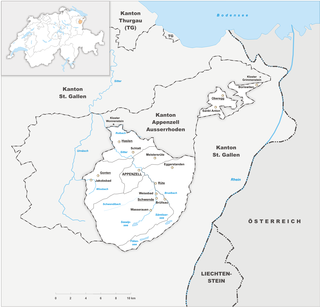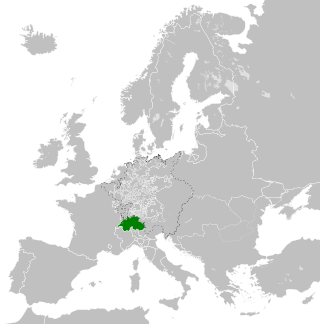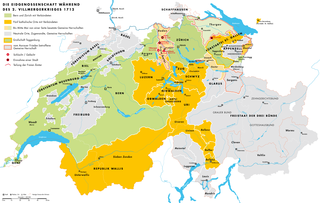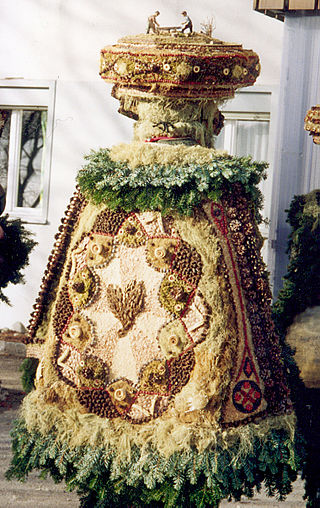
The Abbey of Saint Gall is a dissolved abbey (747–1805) in a Catholic religious complex in the city of St. Gallen in Switzerland. The Carolingian-era monastery existed from 719, founded by Saint Othmar on the spot where Saint Gall had erected his hermitage. It became an independent principality between 9th and 13th centuries, and was for many centuries one of the chief Benedictine abbeys in Europe. The library of the Abbey is one of the oldest monastic libraries in the world.

Appenzell Innerrhoden, in English sometimes Appenzell Inner-Rhodes, is one of the 26 cantons forming the Swiss Confederation. It is composed of five districts. The seat of the government and parliament is Appenzell. It is traditionally considered a "half-canton", the other half being Appenzell Ausserrhoden.

Appenzell Ausserrhoden, in English sometimes Appenzell Outer Rhodes, is one of the 26 cantons forming the Swiss Confederation. It is composed of twenty municipalities. The seat of the government and parliament is Herisau, and the seat of judicial authorities are in Trogen. It is traditionally considered a "half-canton", the other half being Appenzell Innerrhoden.

Teufen is a municipality in the canton of Appenzell Ausserrhoden in Switzerland.

Walzenhausen is a municipality in the canton of Appenzell Ausserrhoden in Switzerland.

Reute is a municipality in the canton of Appenzell Ausserrhoden in Switzerland.

The canton of St. Gallen or St Gall is a canton of Switzerland. Its capital is St. Gallen.
Oberegg District is a district in the canton of Appenzell Innerrhoden in Switzerland. It comprises three small exclaves of the canton, a few kilometers northeast of the rest of Appenzell Innerrhoden.

Appenzell was a canton in the northeast of Switzerland, and entirely surrounded by the canton of St. Gallen, in existence from 1403 to 1597.

The Old Swiss Confederacy, also known as Switzerland or the Swiss Confederacy, was a loose confederation of independent small states, initially within the Holy Roman Empire. It is the precursor of the modern state of Switzerland.

Stoss Pass is a mountain pass between the cantons of Appenzell Innerrhoden and Appenzell Ausserrhoden in Switzerland.

Eastern Switzerland is the common name of the region situated to the east of Glarus Alps, with the cantons of Schaffhausen, Thurgau, St. Gallen, Appenzell Ausserrhoden, Appenzell Innerrhoden, and Glarus. The north of canton of Graubünden is usually considered to be part of Eastern Switzerland as well.

The Appenzell, French: Chèvre d’Appenzell, German: Appenzellerziege, is a rare and endangered indigenous breed of white domestic goat from Switzerland. It originates in the "half-cantons" of the historic Appenzell region, Appenzell Ausserrhoden and Appenzell Innerrhoden, and has spread into the neighbouring Canton of St. Gallen.

The German-speaking part of Switzerland comprises about 65 percent of Switzerland.

The Toggenburg War, also known as the Second War of Villmergen or the Swiss Civil War of 1712, was a Swiss civil war during the Old Swiss Confederacy from 12 April to 11 August 1712. The Catholic "inner cantons" and the Imperial Abbey of Saint Gall fought the Protestant cantons of Bern and Zürich as well as the abbatial subjects of Toggenburg. The conflict was a religious war, a war for hegemony in the Confederacy and an uprising of subjects. The war ended in a Protestant victory and upset the balance of political power within the Confederacy.

Silvesterklaus is a masked person taking part in Saint Sylvester's Day festivities in Appenzell, Switzerland, and thus contributing to maintain the Chlausen tradition. A Silvesterklaus or New Year's Mummer is dressed up as a Saint Sylvester or New Year's Eve character. In the Reformed half-canton of Appenzell Ausserrhoden, the turn of the year is still celebrated in this way. The Silvesterklausen is part of Switzerland’s intangible cultural heritage.

Rosenberg Castle is a ruined castle located near the villages of Burghalden and Schachen to the north of the municipality of Herisau in the canton of Appenzell Ausserrhoden in Switzerland.

The Appenzell–St. Gallen–Trogen railway, also known as the Durchmesserlinie, is a metre gauge interurban tramway in the Swiss cantons of Appenzell Innerrhoden and Ausserrhoden and the city of St. Gallen. It is the steepest adhesion railway in Switzerland with a gradient of up to 8.0% and forms part of the network of the Appenzell Railways (AB) and the St. Gallen S-Bahn. The line's two branches were completed in sections between 1889 and 1904 by the St. Gallen-Gais-Appenzell-Altstätten Railway and the Trogen Railway. The two lines were connected by the AB with a cross-city route in 2018.

Grimmenstein Monastery is a monastery of Sisters of the Third Order of Saint Francis in Walzenhausen in the canton of Appenzell Ausserrhoden in Switzerland. While it is located in Appenzell Ausserrhoden, the buildings and grounds are a small exclave of the canton of Appenzell Innerrhoden.




















